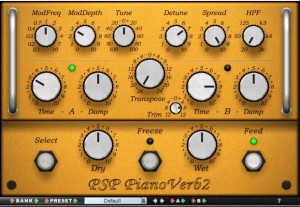Review: PSP SpringBox and PianoVerb2
I’ve been a fan of PSP’s versatile, user-friendly plugins for a while. I think it’s safe to say that at Mason Jar Music, we’ve used the PSP OldTimer compressor on almost every song we’ve mixed.
PSP manages to pair incredibly high-quality processing with simple and thoughtful, yet powerful user interfaces, so when I heard that they were releasing a brand new spring reverb unit and an updated version of their PianoVerb, I was excited by the possibilities. In my experience, many reverb plugins have overly complex UIs, and do not translate quickly in terms of getting the sound you hear in your head to come out of the speakers. But PSP rises to the challenge on both points with the new PSP PSP SpringBox ($69) and PSP PianoVerb2 ($49) plugins.
PSP SpringBox
As a guitar player, I have a special place in my heart for a good spring reverb. There’s a perfect spot on my blackface Fender Pro Reverb where the spring sits just right: it adds depth and character, a subtle warmth and sparkle, without drowning out my natural sound. In an attempt to achieve that same sound in Pro Tools, I used to wire up the spring tank from an old Hammond spinet, but it was always too complicated to dial it in right. So with that experience in mind, my first test of the PSP SpringBox was to set it up as a primary reverb send on an Amy Winehouse-meets-Black Keys style mix I was working on.
Unlike many other spring reverb plugins I’ve tried, the PSP SpringBox can be tamed and controlled to a great degree. It can add lots of vibe or it can sit back as a subtle widener/deepener. The HPF and Damp parameters are great at managing the amount of tail and decay, while the Presence knob functions both to control the overall definition and brightness while also taming the transient response and the classic “spring” sound. I found myself coming back to a setting with minimal “spring” and just enough decay to lightly wet the sound source. The controls are fairly fine, so a little touch goes a long way, which personally I enjoy; it’s like finding the sweet spot on my old Fender.
Though it is not as unabashedly colorful as some other spring emulators plugins, the PSP SpringBox has several built-in multi-spring stereo options, making it much more useful in a far wider variety of scenarios. One great modern improvement PSP has provided is an array of spring configurations. The PSP SpringBox can be switched between 2, 3, 4, and 6 springs, each with slightly different stereo responses (2: I–I; 3: I I I; 4: II–II; 6: III–III). Though the default setting is mono-to-stereo, the SpringBox’s stereo-stereo mode, combined with the four spring models, offer a lot of options for vibey spaces in which to set your mix.
As an effect on an individual instrument, the PSP SpringBox is like a classic reverb tank but with WAY more control. I tried it on a live concert multi-track to add a bit of depth and tail to a DI cello and violin, and was able to very quickly dial in a subtle decay that created a pseudo-amp character without the bite or drive (or intensive signal processing) of an amp emulator. The switchable pan/balance knob is an extremely handy addition for finely tuning the localization of the effect without having to create a separate aux track.
As a straight-up wild FX, the PSP SpringBox ranges from a twangy spring sound to long, ambient wash. PSP designed the UI with two separate sets of controls, which is great for opening up a bolder version of the effect on a chorus, or creating an easily-switchable separate world for big transitions. Having separate Wet and Dry masters, as opposed to one Mix knob, helps to keep the more unruly verbs from drowning out the original sound.
PSP PianoVerb 2
The other new addition to PSP’s catalog is a full-featured (paid) update to the free PSP PianoVerb plugin – an emulation of the classic studio trick of using the resonance of a piano as a reverb.
The PSP PianoVerb2’s UI is designed more like a retro piece of gear or a guitar stompbox (in fact, I kind of wish that Strymon would make a physical version of this), which in itself is a sign of its new greater potential.
While the PianoVerb2 doesn’t totally match the richness of a properly tuned and maintained piano, its new features take it from simply being a gimmicky recreation of an old-school analog trick to revealing a whole new set of sounds that no sand-bag-on-the-sustain pedal could ever have created.
Opening up the Time and Damp controls reveals a palate of incredible, textural reverbs. The addition of proper modulation controls (Freq and Depth), a +/- 2 octave transpose knob, as well as Freeze/Feed buttons take it to the next level. I could happily spend hours creating ambient textures using just the PianoVerb2 and a small string section playing a long chord. My one complaint is that I would have loved an implementation of the Sostenuto pedal, or the ability to select only certain notes to resonate. [Note from PSP on this: You can mimic a Sostenuto by setting up times and dumps for A and B settings to bright long and to dark short, then you can use an A and B switch to transit between both.]
All in all, PSP has lived up to their reputation of powerful, easy-to-use software with these two new verbs. The PSP SpringBox is a tool that I know I will come back to again and again both as a mix-buss reverb and an individual effect. I would love to see a full-featured Plate/Hall/Chamber from PSP in the not-too-distant future.
And who knows, if our schedule ever slows down I might just go ahead and make my string-swell/PianoVerb2 ambient album…
PSPAudioware.com
PSP SpringBox: $69
PSP PianoVerb2: $49
Dan Knobler is a producer and co-founder of Mason Jar Music, an audio & video production house and creative collective based in Brooklyn, NY. Clients include: Andrew Bird, Feist, Rosanne Cash, Tift Merritt, The Wood Brothers. He is a born-and-raised New Yorker and a BBQ enthusiast.
Please note: When you buy products through links on this page, we may earn an affiliate commission.









